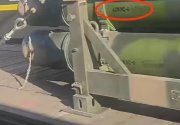That small diameter missile looks close to early block of Korean KM-SAM. I'm curious why China didnt go 9M96 route by having canard control, and side thruster/impulse correction, while tail be left to be free to roll. This will expand the missile's altitude envelope, maneuverability and to maximize the size of the rocket motor that can be packed in (as things with electronics are all at front), and thus range.
The tail control is efficient for high AoA flight, tho the missile might be limited in altitude to some 20-30 km.
The tail control is efficient for high AoA flight, tho the missile might be limited in altitude to some 20-30 km.




